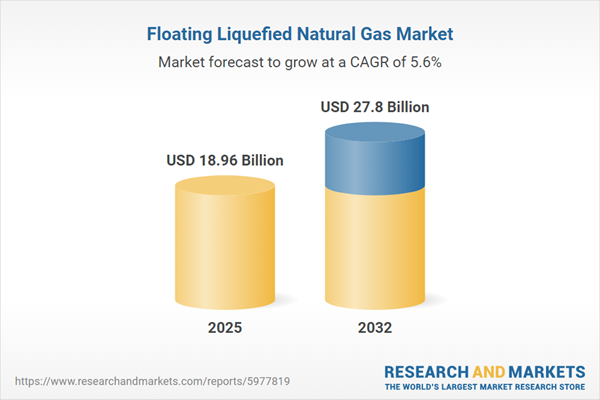Speak directly to the analyst to clarify any post sales queries you may have.
The floating liquefied natural gas (FLNG) market is emerging as a viable pathway for energy producers and infrastructure investors seeking flexible, scalable solutions to evolving energy demands and regulatory pressures. As offshore and remote gas resources grow in strategic importance, FLNG offers senior decision-makers a pragmatic approach to enhancing supply diversity and operational efficiency in challenging environments.
Market Snapshot: Floating Liquefied Natural Gas Market Growth and Dynamics
The global floating liquefied natural gas market grew from USD 17.94 billion in 2024 to USD 18.96 billion in 2025, and is forecast to expand at a CAGR of 5.62% to reach USD 27.80 billion by 2032. This upward trend is supported by rapid decarbonization mandates, the need for energy resilience, and growing adoption of distributed gas infrastructure. Floating solutions are increasingly recognized for their ability to bypass constraints that limit onshore expansion, including regulatory hurdles and environmental sensitivities. Collaboration among project developers, technology licensors, and financing institutions continues to drive innovation and multi-stage project delivery across all major world regions.
Scope & Segmentation: Deep-Dive into Market Structure and Offerings
- Containment Systems: Membrane and Moss technologies, each suited to distinct operational and design requirements.
- Vessel Types: FLNG platforms, floating storage and regasification units (FSRU), and floating storage units (FSU) targeting characteristics from liquefaction to flexible storage.
- Key Technologies: C3MR, mixed refrigerant (dual and single), propane precooling systems designed for efficiency across varying gas compositions.
- Applications: Industrial process, power generation, regasification, and shipping fuel—spanning broad value pools from chemical production to low-carbon marine fuel supply.
- Storage Capacities: Up to 100K cubic meters, 100 to 180K cubic meters, above 180K cubic meters, aligning vessels with project scale and access demands.
- End Users: Industrial manufacturing, petrochemicals, transportation, utilities—mapping to diverse strategic off-taker requirements.
- Operational Status: Deployments at operational, planned, and under-construction stages, reflecting an active and growing global project pipeline.
- Regional Coverage: Americas (North America and Latin America); Europe, Middle East & Africa (key economies and emerging gas producers); Asia-Pacific (major importers and regional technology leaders).
- Leading Companies: Profiles and trends for TechnipFMC, McDermott International, JGC Corporation, KBR, Chiyoda Corporation, MODEC, SBM Offshore, BW Offshore, Golar LNG, and Exmar NV.
Key Takeaways for Senior Stakeholders
- FLNG and FSRU deployments deliver utility-scale capacity with mobility and rapid commissioning, supporting diversified supply strategies and accelerating market entry.
- Integrated digital platforms now enable real-time monitoring of cargo, hull stability, and environmental indicators, supporting predictive asset maintenance for offshore operations.
- Modular construction approaches and multi-region fabrication are streamlining build schedules, mitigating risk, and giving operators flexibility to navigate global supply chain disruptions.
- Strategic partnerships between technology vendors, engineering firms, and national oil companies are central to customized project delivery and operational lifecycle support.
- Regulatory and market shifts are prompting vessel owners and developers to reevaluate sourcing, with local fabrication and design standardization gaining ground for cost and risk management.
Tariff Impact on Floating LNG Supply Chain
The 2025 imposition of United States tariffs on imported FLNG modules and components is impacting global supply chains and capital allocation strategies. Project developers are exploring localized manufacturing, adjusting vendor portfolios, and renegotiating contracts to include cost pass-through clauses. These changes encourage increased domestic fabrication and supply chain resilience, while logistics providers now optimize routes for cost and transit efficiency. Over time, such policy shifts are reinforcing the value of design standardization and local content integrations in the sector.
Methodology & Data Sources
This report relies on rigorous research, combining direct interviews with developers, vessel operators, and technology providers, with analysis of corporate filings, regulatory data, and technical publications. Triangulation and peer review validate insights, ensuring credibility for executive decision-making in the floating liquefied natural gas market.
The Role of Floating Liquefied Natural Gas Market Analysis
- Supports strategic planning by providing clarity on segmentation relevance, competitive positioning, and project pipeline distribution.
- Helps leaders assess technological, regulatory, and partnership trends shaping industry risk and opportunity.
- Offers actionable recommendations for investment prioritization and operational resilience across supply chain nodes.
Conclusion
With floating liquefied natural gas positioned as an enabling platform for energy transition, this report informs how technology, regulation, and business strategy will shape investment and operational outcomes in the sector’s next growth phase.
Additional Product Information:
- Purchase of this report includes 1 year online access with quarterly updates.
- This report can be updated on request. Please contact our Customer Experience team using the Ask a Question widget on our website.
Table of Contents
3. Executive Summary
4. Market Overview
7. Cumulative Impact of Artificial Intelligence 2025
Companies Mentioned
The companies profiled in this Floating Liquefied Natural Gas market report include:- TechnipFMC plc
- McDermott International, Inc.
- JGC Corporation
- KBR, Inc.
- Chiyoda Corporation
- MODEC, Inc.
- SBM Offshore N.V.
- BW Offshore Limited
- Golar LNG Limited
- Exmar NV
Table Information
| Report Attribute | Details |
|---|---|
| No. of Pages | 186 |
| Published | October 2025 |
| Forecast Period | 2025 - 2032 |
| Estimated Market Value ( USD | $ 18.96 Billion |
| Forecasted Market Value ( USD | $ 27.8 Billion |
| Compound Annual Growth Rate | 5.6% |
| Regions Covered | Global |
| No. of Companies Mentioned | 11 |









